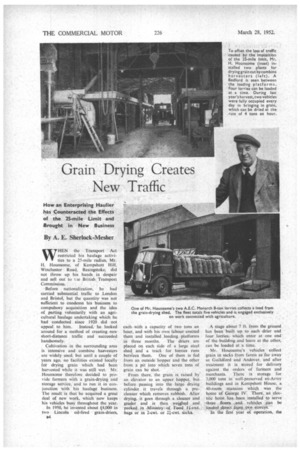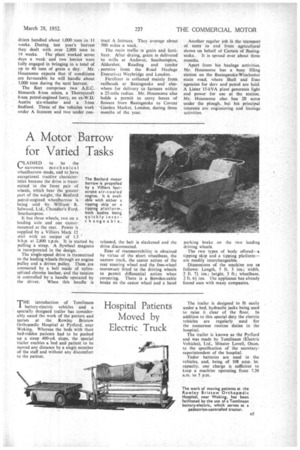Grain Drying Creates New Traffic
Page 38

Page 39

If you've noticed an error in this article please click here to report it so we can fix it.
By A. E. Sheriock-Mesher
WHEN the Transport Act restricted his haulage activities to a 25-mile radius, Mr. H. Hounsomc, of Kernpshott Hill, Winchester Road, Basingstoke, did not throw up his hands in despair and sell out to t.i.e British_ Transport Commission.
Before nationalization, he had carried substantial traffic to London and Bristol, but the quantitywas not sufficient to condemn his business to compulsory acquisition and the idea of parting voluntarily with an agricultural haulage undertaking which he had conducted since 1920 did not appeal. to him. instead, helooked around for a method of creating new short-distance traffic and succeeded handsomely. .
• Cultivation in the surrounding area is intensive and combine hetvestersare widely used, but until a couple of years ago, no facilities existed locally for drying grain which had been harvested while it was still wet. Mr. Hounsorne therefore decided to provide farmers with a grain-drying arid storage service, and to run it in conjunction With his haulage business. The result is that he acquired a great deal of new work, which now keeps his vehicles busy throughout the year.
In 1950, he invested about 44,000 in two -Lincoln oil-fired grain-driers, a4 each with a capacity of two tons an hour, and with his own labour erected them and installed loading platforms in three months. The driers are placed On each side of a large steel shed and a track for lorries runs • betWeen them. One of them is fed from an outside hopper and the other from a pit into which seven tons of grain Can be shot. .
From there, the grain is raised by an elevator to an upper, hopper, but before passing into the large drying cylinder it travels through a precleaner which removes rubbish. After drying, it goes through a cleaner and grader and is then weighed Etnci Pac:k4Food bags Or in 2-cwt. or 21-ewt, saCks. A stage about 7 ft. from the ground has been built up to each drier and four lorries,which enter at one end of the building and leave at the other, can be loaded at .a time
Mr. Houpsome's vehicles collect grain in sacks from farms as far away as Guildford and Andover, and after treatment it is stored for delivery against the orders of farmers and merchants. There is storage for 3,000 tons in well-preserved eX-Army buildings and in Kempshott House, .a 40-room mansion which was the home of George IV. There, an _eke
• tric hoist. has:.. been installed to serve -three floors ,and, vehicics ..,can be -loaded direct fronas.two storeys,
In the first Year of operation, the driers handled about 1,000 tons in 11 weeks. During last year's harvest they dealt with over 2,000 tons in 14 weeks. The plant worked seven days a week and two lorries were fully engaged in bringing in a total of up to 40 tons of grain a day. Mr. Hounsorne expects that if conditions are favourable he will handle about 3,000 tons during the next harvest.
The fleet comprises two A.E.C. Monarch 8-toii oilers, a Thornycroft 8-ton petrol-engined lorry, an ex-W.D. Austin six-wheeler and a 3-ton Bedford. Three of the vehicles work under A licences and two under con
tract A licences. They average about • 500 miles a week.
The main traffic is grain and fertilizer. After drying, grain is delivered to mills at Andover, Southampton, Aldershot, Reading and (under perm its from the Road Haulage Executive) Weybridge and London.
Fertilizer is collected mainly from railheads at Basingstoke and elsewhere for delivery to farmers within a 25--mile radius. Mr. Hounsome also holds a permit to carry boxes of
• flowers from Basingstoke to Covent 'Garden Market, London, during three months of the year. Another regular job A. the transport of tents to and from agricultural shows on behalf of Carters of Basing stoke. It is spread over about three months.
Apart from his haulage activities, Mr. Hounsonte has a busy filling station on the Basingstoke-Winchester main road, where Shell and Esso agencies for dery and petrol are held. A Lister 15-kVA plant generates light and power for use at the station. Mr. Hounsome also has 20 acres under the plough, but his principal interests are engineering and haulage activities.




















































































